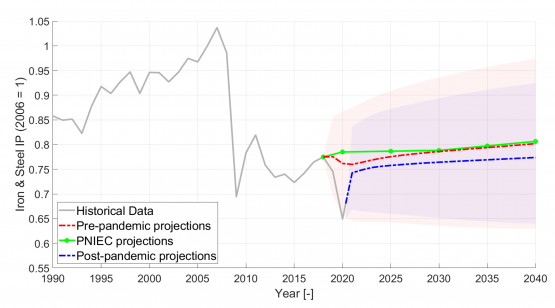Post-pandemic industrial drivers
In models of the TIMES family, estimates of energy service demands are generally provided by the modeler, either through exogenously specified arrays of values obtained from e.g., general equilibrium models, or by computing them via equations relating demands to their elasticities to socio-economic developments.
The twofold challenges of computing demand evolution should take into account that:
- When driver projections are retrieved from external sources, those drivers should be internally coherent as well;
- Elasticities should be computed based on econometric analyses, able to capture changing patterns in energy service demands in relation to socio-economic growth, such as a saturation in some energy end-use demands, in-creased urbanization, or changes in consumption patterns once the basic needs are satisfied.
This activity has the aim of applying simple Vector AutoRegressive (VAR) models to industrial production drivers in TIMES-Italia to assess the long-lasting effects of the COVID-19 pandemic and to demonstrate the validity of such tools. In Figure 1, the results of the projections for the Iron and Steel subsector are represented in three cases: Pre-pandemic projections (using TIMES-Italy drivers), Post-pandemic projections (computed via VAR models) and PNIEC projections.

Figure 2. Iron and steel subsector industrial production projections. The light red area encloses the 95% confidence bound related to the pre-pandemic projections, while the light blue area represents the range enclosed within the 95% confidence bounds related to the post-pandemic projections.
A. Oliva, F. Gracceva, D. Lerede, M. Nicoli, L. Savoldi, "Projection of Post-Pandemic Italian Industrial Production through Vector AutoRegressive Models", Energies, vol. 14(17), 5458, 2021.

